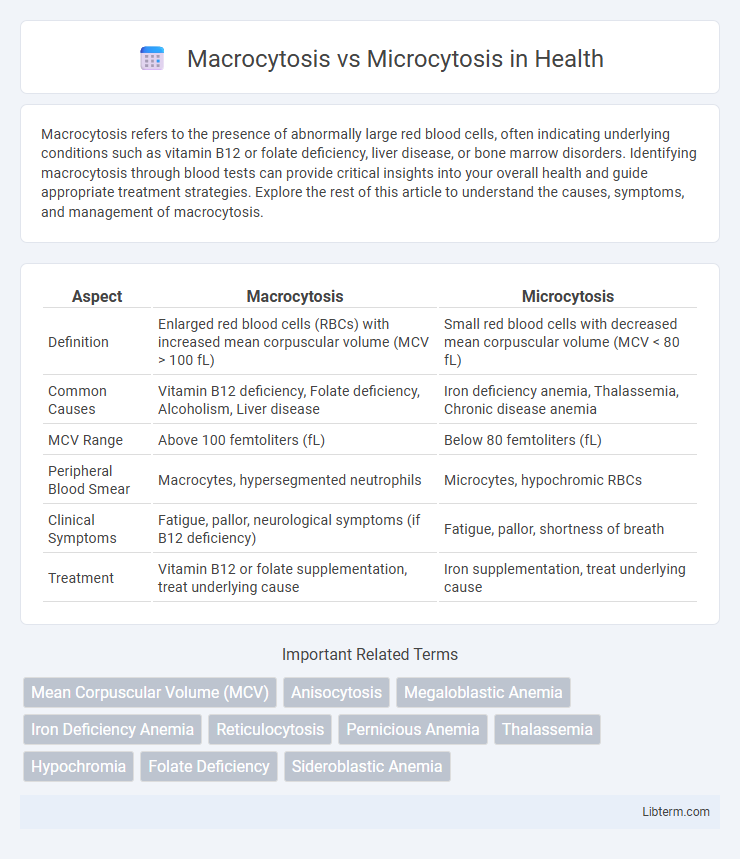Macrocytosis refers to the presence of abnormally large red blood cells, often indicating underlying conditions such as vitamin B12 or folate deficiency, liver disease, or bone marrow disorders. Identifying macrocytosis through blood tests can provide critical insights into your overall health and guide appropriate treatment strategies. Explore the rest of this article to understand the causes, symptoms, and management of macrocytosis.
Table of Comparison
| Aspect | Macrocytosis | Microcytosis |
|---|---|---|
| Definition | Enlarged red blood cells (RBCs) with increased mean corpuscular volume (MCV > 100 fL) | Small red blood cells with decreased mean corpuscular volume (MCV < 80 fL) |
| Common Causes | Vitamin B12 deficiency, Folate deficiency, Alcoholism, Liver disease | Iron deficiency anemia, Thalassemia, Chronic disease anemia |
| MCV Range | Above 100 femtoliters (fL) | Below 80 femtoliters (fL) |
| Peripheral Blood Smear | Macrocytes, hypersegmented neutrophils | Microcytes, hypochromic RBCs |
| Clinical Symptoms | Fatigue, pallor, neurological symptoms (if B12 deficiency) | Fatigue, pallor, shortness of breath |
| Treatment | Vitamin B12 or folate supplementation, treat underlying cause | Iron supplementation, treat underlying cause |
Introduction to Macrocytosis and Microcytosis
Macrocytosis is characterized by the presence of abnormally large red blood cells, often linked to vitamin B12 or folate deficiencies, while microcytosis involves smaller than normal red blood cells, commonly associated with iron deficiency anemia or thalassemia. Both conditions are detected through a complete blood count (CBC) test measuring mean corpuscular volume (MCV), where elevated MCV indicates macrocytosis and decreased MCV suggests microcytosis. Understanding these variations in red blood cell size is crucial for diagnosing underlying hematologic disorders and guiding appropriate treatment strategies.
Defining Macrocytosis: Key Features
Macrocytosis is characterized by an elevated mean corpuscular volume (MCV) exceeding 100 fL, indicating abnormally large red blood cells. Key features include decreased DNA synthesis often linked to vitamin B12 or folate deficiency, leading to impaired cell division and enlarged erythrocytes. This condition contrasts with microcytosis, which involves smaller-than-normal red blood cells typically caused by iron deficiency or thalassemia.
Defining Microcytosis: Key Features
Microcytosis is characterized by the presence of smaller-than-normal red blood cells, typically with a mean corpuscular volume (MCV) below 80 femtoliters. It commonly indicates iron deficiency anemia, thalassemia, or chronic disease, affecting hemoglobin synthesis and oxygen transport. Key features include hypochromic, microcytic erythrocytes observed on a peripheral blood smear and reduced hemoglobin concentration per red blood cell.
Causes of Macrocytosis
Macrocytosis primarily results from vitamin B12 or folate deficiency, leading to impaired DNA synthesis in red blood cell production. Other causes include liver disease, hypothyroidism, alcoholism, and certain medications such as hydroxyurea or methotrexate. Unlike microcytosis, which is often caused by iron deficiency or thalassemia, macrocytosis reflects enlarged red blood cells due to disrupted maturation processes.
Causes of Microcytosis
Microcytosis, characterized by smaller than normal red blood cells, primarily results from iron deficiency anemia, thalassemia, and chronic diseases affecting hemoglobin synthesis. In contrast, macrocytosis involves enlarged red blood cells, often caused by vitamin B12 or folate deficiency and bone marrow disorders. Understanding the distinct etiologies of microcytosis aids in accurate diagnosis and targeted treatment strategies.
Clinical Significance: Macrocytosis vs Microcytosis
Macrocytosis often indicates conditions like vitamin B12 or folate deficiency, liver disease, or bone marrow disorders, presenting with enlarged red blood cells that can impair oxygen delivery. Microcytosis typically signals iron deficiency anemia, thalassemia, or chronic disease, characterized by smaller-than-normal red blood cells that reduce hemoglobin synthesis. Recognizing these distinct red blood cell size abnormalities enables targeted diagnosis and treatment, improving patient outcomes in hematological assessments.
Diagnostic Approach and Laboratory Evaluation
Macrocytosis is characterized by enlarged red blood cells with a mean corpuscular volume (MCV) exceeding 100 fL, often evaluated through serum vitamin B12, folate levels, and liver function tests to identify causes like megaloblastic anemia or liver disease. Microcytosis presents with smaller red blood cells and an MCV below 80 fL, primarily assessed by iron studies including serum ferritin, transferrin saturation, and hemoglobin electrophoresis to diagnose iron deficiency anemia or thalassemia. A comprehensive diagnostic approach integrates peripheral blood smear examination alongside targeted laboratory assays to differentiate underlying etiologies and guide appropriate treatment.
Common Symptoms and Presentation
Macrocytosis often presents with symptoms such as fatigue, pallor, and shortness of breath, reflecting underlying anemia caused by enlarged red blood cells. Microcytosis is commonly associated with symptoms like weakness, dizziness, and pale skin, typically resulting from iron deficiency or hemoglobin synthesis disorders leading to smaller-than-normal red blood cells. Both conditions may show signs of anemia, but the distinct cell size differences are key indicators in diagnostic blood tests.
Treatment Strategies for Macrocytosis and Microcytosis
Treatment strategies for macrocytosis primarily involve addressing underlying causes such as vitamin B12 or folate deficiency, often managed through supplementation and dietary adjustments, along with treating any associated bone marrow disorders. Microcytosis treatment focuses on correcting iron deficiency anemia through iron supplementation and dietary modifications, while genetic conditions like thalassemia may require specialized therapies such as blood transfusions or chelation therapy. Both conditions benefit from targeted diagnostic evaluation to tailor therapy effectively and monitor response to treatment.
Prognosis and Long-Term Outcomes
Macrocytosis, characterized by enlarged red blood cells often caused by vitamin B12 or folate deficiency, typically has a favorable prognosis when the underlying cause is promptly identified and treated, reducing the risk of neurological complications and anemia-related morbidity. Microcytosis, usually resulting from iron deficiency anemia or thalassemia, requires targeted management to prevent chronic anemia, growth retardation in children, and cardiac strain, influencing long-term outcomes significantly. Both conditions necessitate accurate diagnosis and ongoing monitoring to optimize treatment strategies and minimize complications, improving patient quality of life over time.
Macrocytosis Infographic

 libterm.com
libterm.com